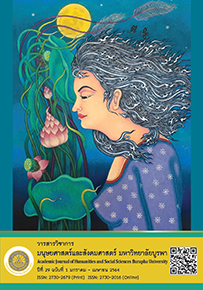The Narrative and Creation Strategies of Halal Films
Main Article Content
Abstract
This qualitative study aimed to investigate the narrative and creation strategies of Halal films. Data collection included textual analysis, in-depth interview and analysis of relevant documents used to promote the films. The findings indicated that the plots were tied to the lifestyle of Muslims and Islam. The narrative conflicts were created by the characters who had to choose between what was right and wrong according to the norms of Islam. The concept of the Halal films was underpinned by the value of the doctrine of Islam, good image of Muslims and Islam and the results of those who believed in Islam which would eventually find true happiness. Regarding the production processes of the Halal films, it was found that crowdfunding was used as a tool to raise funds for making the films. The actors and film crew took part in the films through the idea of shared ideology. In the shooting process, the Muslim ways of living were applied. For the post-production, compositions of the entertainment qualities were reduced. The screening and distribution of the Halal films were limited to small viewing areas. The study illustrated the way in which the Halal film directors negotiated between the art of film and Islamic rules. Also, this study pointed out the role of alternative media that helped create a space for the Muslim community in the Thai society.
Downloads
Article Details
บทความทุกบทความเป็นลิขสิทธิ์ของวารสารวิชาการมนุษยศาสตร์และสังคมศาสตร์ มหาวิทยาลัยบูรพาเท่านั้น
References
Journalist in Philippines. (2558). สื่อและสิทธิการสื่อสารภาคประชาชน. เข้าถึงได้จาก http://journalistinph.blogspot.com
ดวงหทัย กอหลวง. (2555). ความสำคัญของกระดานสนทนาออนไลน์ด้านความงามต่อกระบวนการตัดสินใจซื้อเครื่องสำอางของผู้บริโภค. วิทยานิพนธ์บริหารธุรกิจมหาบัณฑิต, สาขาวิชาการตลาด, คณะบริหารธุรกิจ, มหาวิทยาลัยเชียงใหม่.
ไทยพับลิก้า. (2558). Crowdfunding ไอเดียธุรกิจแบบใหม่ กุญแจคือความซื่อสัตย์ โปร่งใส และความคิดสร้างสรรค์. เข้าถึงได้จาก https://thaipublica.org/2015/02/crowdfunding
ธัญรัศม์ สะละหมัด. (2549). อิสลาม-สื่อ-ความรุนแรง: ปฏิสัมพันธ์บนเส้นทางการสร้างภาพลักษณ์ความรุนแรง. วิทยานิพนธ์ปรัชญาดุษฎีบัณฑิต, สาขาวิชาสหวิทยาการ, สำนักงานบัณฑิตศึกษา, มหาวิทยาลัยธรรมศาสตร์.
ธีรพันธ์ โล่ห์ทองคำ. (2545). IMC in action. กรุงเทพฯ: ทิปปิ้ง พอยท์.
บรรจง โกศัลวัฒน์. (2529). การกำกับ (และ) การแสดงในภาพยนตร์. กรุงเทพฯ: เฮาท์.
ประสิทธิ์ อุทาเลิศ. (2553). กระบวนการประชาสัมพันธ์เว็บไซต์พาณิชย์อิเล็กทรนิกส์แบบ SEO สำหรับเว็บไซต์บิวตี้เมโลดี. วิทยานิพนธ์บริหารธุรกิจมหาบัณฑิต, สาขาวิชาการบริหารธุรกิจ, คณะบริหารธุรกิจ, มหาวิทยาลัยเชียงใหม่.
พงศวีร์ สุภานนท์. (2561). การปรับตัวในการเล่าเรื่องของผู้กำกับภาพยนตร์นอกกระแสภายใต้ระบบทุนนิยมของอุตสาหกรรมภาพยนตร์ไทย. วิทยานิพนธ์นิเทศศาสตรดุษฎีบัณฑิต, สาขาวิชานิเทศศาสตร์, คณะนิเทศศาสตร์, มหาวิทยาลัยธุรกิจบัณฑิตย์.
พรจันทร์ เสียงสอน. (2557). การนำเสนอผู้หญิงและความรุนแรงในภาพยนตร์ไทย. วิทยานิพนธ์ศิลปศาสตรมหาบัณฑิต, สาขาวิชาการสื่อสารประยุกต์, คณะภาษาและ การสื่อสารสาร, สถาบันบัณฑิตพัฒนบริหารศาสตร์.
ภากิตติ์ ตรีสุกล. (2551). หลักนิเทศศาสตร์ (พิมพ์ครั้งที่ 6). กรุงเทพฯ: มหาวิทยาลัยราชภัฏสวนสุนันทา.
มาโนช ชุ่มเมืองปัก. (2560). การผลิตสื่อทางเลือกโดยชาวไทยเชื้อสายปกาเกอะญอ. กรุงเทพฯ: คณะนิเทศศาสตร์, มหาวิทยาลัยธุรกิจบัณฑิตย์.
ศูนย์ข้อมูลและข่าวสืบสวนเพื่อสิทธิพลเมือง. (2558). Re-define‘สื่อทางเลือก’ยุคสงครามข่าวสารบนทางแพร่งทุน-อิสระ-มืออาชีพ?. เข้าถึงได้จาก https://www.tcijthai.com/news/2015/01/scoop/5426
สมคเน วรวิวัฒน์. (2553). การบริหารงานกองถ่ายทําภาพยนตร์ไทย: กรณีศึกษาผู้กํากับที่เป็นศิลปินตลก. วิทยานิพนธ์วารสารศาสตรมหาบัณฑิต, สาขาวิชาการบริหารสื่อสารมวลชน, คณะวารสารศาสตร์และสื่อสารมวลชน, มหาวิทยาลัยธรรมศาสตร์.
สรัสนันท์ คำดีบุญ. (2559). กลยุทธ์การสื่อสารการตลาดของภาพยนตร์นอกกระแสของประเทศไทยผ่านสื่อสังคมออนไลน์. วิทยานิพนธ์นิเทศศาสตรมหาบัณฑิต, สาขาวิชานิเทศศาสตร์และนวัตกรรม, คณะนิเทศศาสตร์และนวัตกรรมการจัดการ, สถาบันบัณฑิตพัฒนบริหารศาสตร์.
อัญชลี ชัยวรพร. (2556). ทฤษฎีและการวิจารณ์ภาพยนตร์เบื้องต้น (พิมพ์ครั้งที่ 4). นนทบุรี: มหาวิทยาลัยสุโขทัยธรรมาธิราช.
O’Sullivan, T., Hartley, J., Saunders, D., Montgomery, M., & Fiske, J. (1994). Key concepts in communication and cultural studies. London: Routledge.


